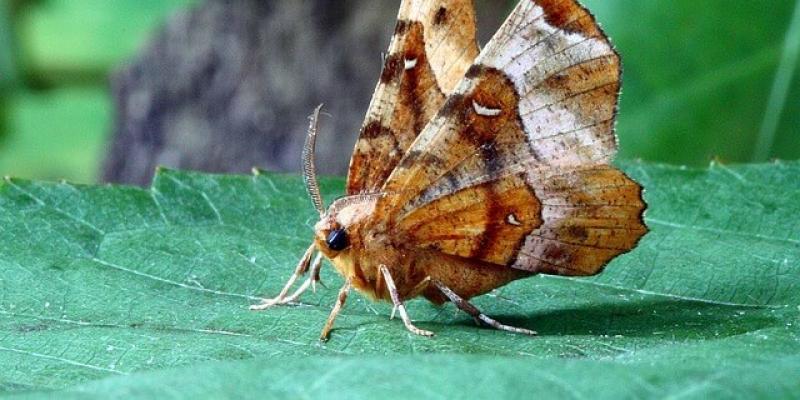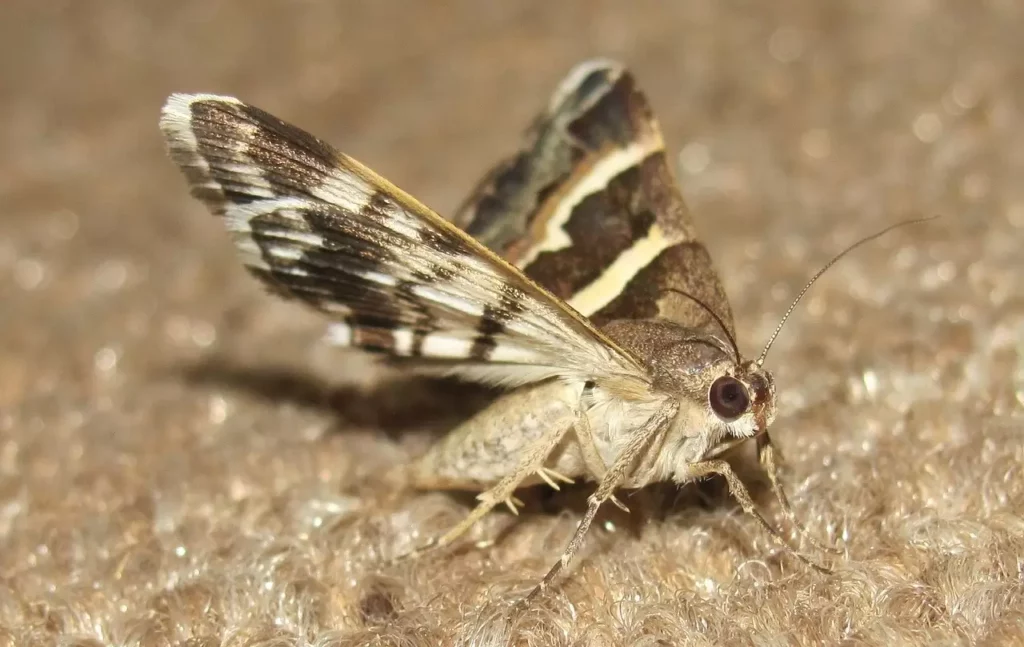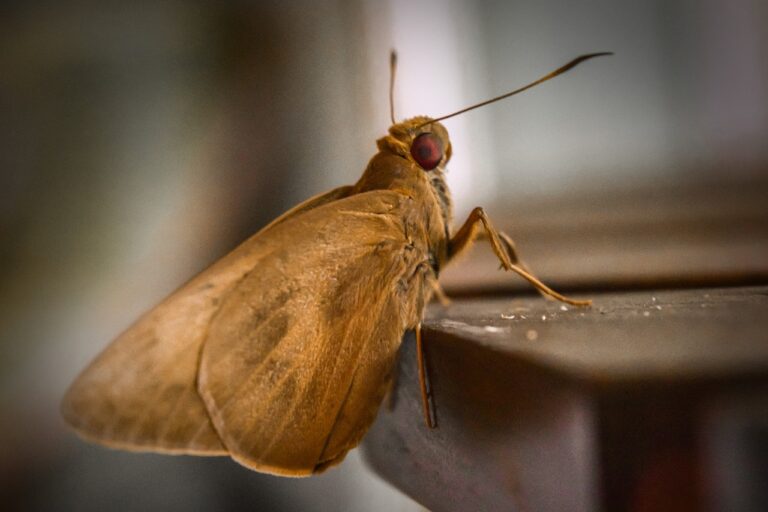Moths are attracted to various stimuli, including light, odors, and chemicals, depending on the species. They are famously drawn to artificial lights at night, can be attracted to the scent of flowers or mates’ pheromones, and may infest stored food products like grains.
Moreover, some moths are specialized, seeking out specific host plants for mating or feeding. Moths exhibit diverse behaviors, and their preferences can vary widely.
How are moths attracted to artificial lights?
These various factors that attract moths are essential for pest control, conservation efforts, and minimizing damage to clothing and food items. It also highlights the fascinating and diverse behaviors of these insects in response to different environmental cues.
Light
Moths exhibit a behavior called phototaxis, which means they are naturally drawn to light. This behavior has evolved as a way for moths to navigate by using the moon and stars for orientation.
However, artificial lights can confuse this navigational system, causing moths to circle light sources or fly towards them.
Moths are particularly attracted to artificial lights at night. This attraction can be so strong that it sometimes leads them away from their natural habitats and into urban areas. While scientists don’t fully understand why moths are attracted to lights.
Theories suggest that they may mistake artificial lights for the moon or use them as reference points for navigation.
Odors and Chemicals

Many moth species use chemical signals called pheromones to communicate and find mates. Female moths release specific pheromones that are detected by males from a distance.
Moreover, these pheromones can be highly species-specific, ensuring that males of the same species are attracted to the correct females for mating.
Some moths are attracted to scents produced by flowers and fruit. This attraction serves a dual purpose – it can lead moths to nectar sources for feeding and also promote pollination as moths inadvertently transfer pollen from one flower to another while feeding.
Dark Clothing
Clothes moths, such as the common clothes moth (Tineola bisselliella), are notorious for their attraction to dark and woolen fabrics.
Additionally, they lay their eggs on these materials, and their larvae feed on natural fibers like wool, silk, and fur. This behavior can lead to damage to clothing and textiles.
When clothes moths infest an area, they can be challenging to eradicate. Effective prevention measures include storing clothing properly, maintaining cleanliness, and using moth repellents.
Food Sources
Pantry Moths and Stored Food Products: Pantry moths, also known as Indian meal moths (Plodia interpunctella), are attracted to stored food products like grains, cereals, flour, and dried fruits.
Moreover, they lay eggs on these items, and their larvae consume the food, leading to contamination and spoilage. Proper food storage and regular inspection can help prevent infestations.
Heat
Attraction to Infrared Radiation: Some moths are attracted to heat sources that emit infrared radiation. Infrared radiation is a form of heat energy, and certain moths, especially those that are crepuscular or nocturnal, can perceive it as a cue for finding warm and sheltered locations.
Furthermore, this attraction to heat can sometimes lead moths into homes where warm, artificial sources of heat are present.
Ultraviolet (UV) Light
Attraction to UV Patterns in Nature: Some moths, particularly nocturnal ones, are attracted to ultraviolet (UV) light patterns that are naturally present in the environment.
Flowers often have distinctive UV patterns or markings, known as nectar guides, that guide nocturnal pollinators like moths to their nectar.
These UV patterns are invisible to humans but are highly visible to moths, serving as landing guides to facilitate successful pollination.
UV patterns on flowers serve as a visual cue, helping moths locate and land on the flower. As moths feed on nectar, they inadvertently transfer pollen from one flower to another, aiding in the pollination process.
Moths have developed specialized photoreceptors in their compound eyes to detect UV light, allowing them to effectively navigate to and from flowers during their nocturnal foraging activities.
Mating Signals
Pheromones are chemical substances produced by female moths to attract males for mating. These pheromones are species-specific, meaning that each species of moth produces a unique blend of pheromones that only members of the same species can detect and respond to.
Additionally, female moths release pheromones into the air, creating a chemical plume that spreads downwind. Male moths have specialized antennae equipped with receptors designed to detect these pheromones, allowing them to locate potential mates from a considerable distance.
On the other hand, when a male moth detects a female’s pheromone plume, he will engage in a series of behaviors to locate and court the female. These behaviors may include flying upwind toward the source of the pheromone, engaging in a zigzagging flight pattern, and making physical contact with the female once located.
Understanding the pheromone-based communication of moths is crucial in pest control strategies. Scientists have developed pheromone traps that exploit this communication to monitor and control moth populations by luring males into traps, disrupting mating patterns, and reducing pest damage.
Specific Host Plants
Many moth species are highly specialized in their choice of host plants. This specialization often corresponds to the food requirements of their caterpillar larvae. For example:
Monarch caterpillars feed exclusively on milkweed plants (Asclepias species), as milkweed contains toxic compounds called cardenolides that make monarchs unpalatable to predators.
Swallowtail butterfly species, like the Eastern Tiger Swallowtail, have specific host plants. The caterpillars of this butterfly feed on plants in the genus Prunus, which includes cherry and plum trees.
The caterpillars of some sphinx moths, often referred to as hornworms, have host plant preferences. For instance, the tobacco hornworm feeds on tobacco plants (Nicotiana spp.), while the tomato hornworm prefers tomato plants (Solanum spp.).
Specialized moths often have unique physiological and behavioral adaptations that enable them to metabolize or tolerate the chemical defenses of their chosen host plants.
What contributes to the diversity of moth species’ behaviors?

Moths’ adaptability and diverse behaviors have allowed them to occupy a wide range of ecological niches and play vital roles in ecosystems worldwide.
Diversity of Moth Species
- Rich Species Diversity: Moths belong to the order Lepidoptera, which includes a staggering number of species, estimated at over 160,000. This diversity means that moth behavior can vary significantly from one species to another.
- Morphological Differences: Moth species vary in size, coloration, wing patterns, and other morphological traits, and these differences often correlate with specific behaviors and ecological niches.
- Ecological Roles: Moths play diverse ecological roles, such as pollinators, herbivores, detritivores, and predators, which further contribute to the wide range of behaviors observed among moth species.
Environmental Factors
Moth behavior is strongly influenced by the specific habitats they inhabit. For example, moths in tropical rainforests may have different behaviors compared to those in arid deserts. Geographic location also affects behaviors, with moths in different regions adapting to local climates and resources.
Seasonal variations, such as temperature, photoperiod (day length), and food availability, can impact moth behavior. Some species are migratory and exhibit seasonal movements, while others enter diapause (a period of dormancy) to survive harsh conditions.
Evolutionary Adaptations
Moths that have specialized in feeding on specific host plants often exhibit remarkable adaptations.
For example, some moths have evolved detoxification mechanisms to cope with plant toxins, while others have developed camouflage patterns to avoid detection by predators.
Evolutionary adaptations for predator avoidance include cryptic coloration, mimicry, and behaviors like rapid flight or playing dead. For instance, the Luna moth has large, eye-catching wings that can startle potential predators.
Varying Preferences Among Moths
Moth species can have varying feeding preferences. Some are nectar feeders, visiting flowers for sustenance and pollinating them in the process. Others are herbivores, feeding on leaves, stems, or roots of plants. There are also predatory moths that hunt other insects.
While most moths are nocturnal and are active at night, some are diurnal (active during the day). Diurnal moths often have different behaviors and adaptations than their nocturnal counterparts.
Moth mating behaviors differ, with some species engaging in elaborate courtship rituals, while others rely more on pheromone-based communication. Reproductive strategies can also vary, with some moths producing large numbers of eggs, while others invest more in parental care.
Certain moth species exhibit migratory behaviors, traveling long distances between breeding and overwintering sites. The Monarch butterfly, for example, migrates thousands of miles between North America and Mexico.
Some moths are solitary and live independently, while others form social groups or colonies. For instance, some tent-making moths construct communal shelters for protection.
FAQ’s
How do you get rid of moths?
To get rid of moths, start by identifying the type of moths you’re dealing with (pantry moths, clothes moths, etc.). Then, implement preventive measures such as proper food storage, maintaining cleanliness, and using moth repellents or traps. For clothes moths, launder infested items, freeze them, or use heat to kill larvae. For pantry moths, discard infested food items and clean your pantry thoroughly.
What attracts clothes moths?
Clothes moths are attracted to natural fibers like wool, silk, and fur found in clothing and textiles. They are also drawn to dark, undisturbed areas where they can lay their eggs and where larvae can feed on these materials.
What smells do moths hate?
Moths dislike strong scents such as those from cedarwood, lavender, rosemary, mint, and cloves. These natural scents act as repellents and can deter moths from infesting your clothes or pantry.
How do I get rid of moths in my room ASAP?
To quickly get rid of moths in a room, open windows and doors to allow them to fly out. Use a moth repellent spray or hang sachets of cedar, lavender, or other repellent herbs in your room. Vacuum thoroughly to remove any larvae or eggs, and wash or dry-clean infested clothing.
What is a natural killer for moths?
Natural killers for moths include essential oils like cedarwood, lavender, and eucalyptus. Placing cedar blocks, lavender sachets, or eucalyptus branches in closets and drawers can help repel moths. Additionally, freezing or heating infested items can kill moth larvae.
What is the best moth killer?
The best moth killer depends on the context. For clothes moths, vacuuming, laundering, freezing, or using heat treatments can be effective. Pantry moths can be controlled with proper food storage and cleaning. Moth repellents like cedar blocks, lavender sachets, and moth traps are commonly used for prevention and control. If infestations persist, professional pest control services may be necessary.
Final Thought
In conclusion, moths exhibit a fascinating array of behaviors and attractions that span a diverse spectrum of stimuli. Their responsiveness to light, pheromones, scents, and host plants showcases the complexity of their sensory adaptations.
Moths’ behaviors are further shaped by factors such as habitat, environmental conditions, and evolutionary adaptations, making them highly adaptable creatures.
This diversity among moth species underscores the importance of understanding their behaviors, not only for pest management and conservation but also for appreciating their intricate roles within ecosystems.
In addition, the intricate web of interactions and preferences among moths adds to the richness of our natural world, inviting continued exploration and study.

